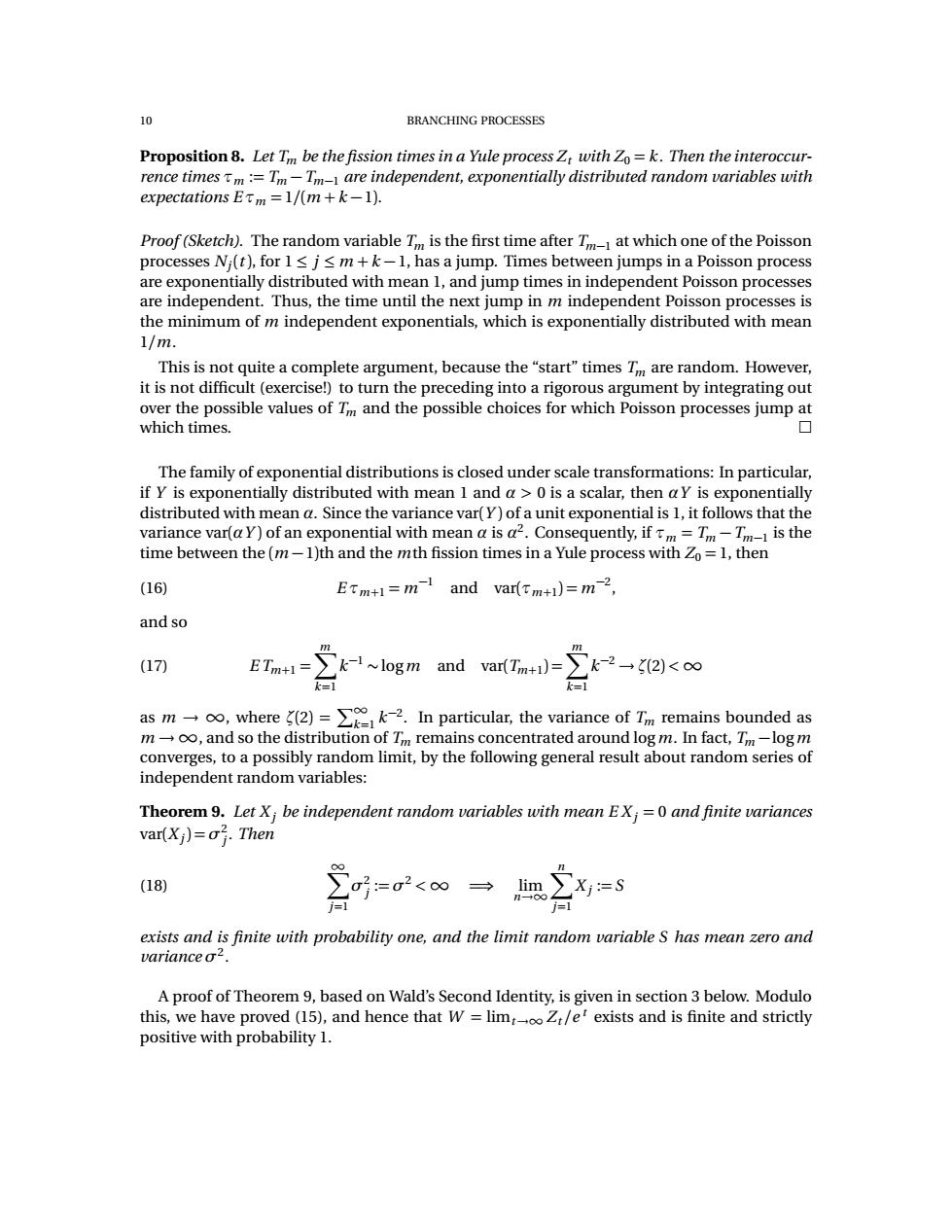正在加载图片...

10 BRANCHING PROCESSES Proposition 8.Let Tm be the fission times in a Yule process Z with Zo=k.Then the interoccur- rence timesTm:=Tm-Tm-are independent,exponentially distributed random variables with expectations ETm =1/(m+k-1). Proof(Sketch).The random variable Tim is the first time after Ti-1 at which one of the Poisson processes Ni(t),for 1s js m+k-1,has a jump.Times between jumps in a Poisson process are exponentially distributed with mean 1,and jump times in independent Poisson processes are independent.Thus,the time until the next jump in m independent Poisson processes is the minimum of m independent exponentials,which is exponentially distributed with mean 1/m. This is not quite a complete argument,because the "start"times Tm are random.However, it is not difficult(exercise!)to turn the preceding into a rigorous argument by integrating out over the possible values of Tm and the possible choices for which Poisson processes jump at which times. 口 The family of exponential distributions is closed under scale transformations:In particular, if y is exponentially distributed with mean 1 and a>0 is a scalar,then ay is exponentially distributed with mean a.Since the variance var(Y)of a unit exponential is 1,it follows that the variance var(a y)of an exponential with mean a is a2.Consequently,ifm=Ti-Tim-1 is the time between the(m-1)th and the mth fission times in a Yule process with Zo=1,then (16) ETm+i=m and var(tm+1)=m 2, and so 12 177 (17) E Tm+1= k-1~logm and var(Tm+)=∑k-2g2)<o k= k= asm-→o,where(2)=】 In particular,the variance of T remains bounded as m-oo,and so the distribution of Tm remains concentrated around log m.In fact,Tm-log m converges,to a possibly random limit,by the following general result about random series of independent random variables: Theorem 9.Let X;be independent random variables with mean EX;=0 and finite variances var(Xj)=o.Then ●X (18) =2<0 → lim =S exists and is finite with probability one,and the limit random variable S has mean zero and varianceσ2. A proof of Theorem 9,based on Wald's Second Identity,is given in section 3 below.Modulo this,we have proved(15),and hence that W=limZ/e exists and is finite and strictly positive with probability 1.10 BRANCHING PROCESSES Proposition 8. Let Tm be the fission times in a Yule process Zt with Z0 = k. Then the interoccurrence times τm := Tm − Tm−1 are independent, exponentially distributed random variables with expectations E τm = 1/(m + k − 1). Proof (Sketch). The random variable Tm is the first time after Tm−1 at which one of the Poisson processes Nj (t ), for 1 ≤ j ≤ m + k − 1, has a jump. Times between jumps in a Poisson process are exponentially distributed with mean 1, and jump times in independent Poisson processes are independent. Thus, the time until the next jump in m independent Poisson processes is the minimum of m independent exponentials, which is exponentially distributed with mean 1/m. This is not quite a complete argument, because the “start” times Tm are random. However, it is not difficult (exercise!) to turn the preceding into a rigorous argument by integrating out over the possible values of Tm and the possible choices for which Poisson processes jump at which times. The family of exponential distributions is closed under scale transformations: In particular, if Y is exponentially distributed with mean 1 and α > 0 is a scalar, then αY is exponentially distributed with mean α. Since the variance var(Y ) of a unit exponential is 1, it follows that the variance var(αY ) of an exponential with mean α is α 2 . Consequently, if τm = Tm − Tm−1 is the time between the (m − 1)th and the mth fission times in a Yule process with Z0 = 1, then (16) E τm+1 = m−1 and var(τm+1 ) = m−2 , and so (17) E Tm+1 = Xm k=1 k −1 ∼ logm and var(Tm+1 ) =Xm k=1 k −2 → ζ(2) <∞ as m → ∞, where ζ(2) = P∞ k=1 k −2 . In particular, the variance of Tm remains bounded as m →∞, and so the distribution of Tm remains concentrated around logm. In fact, Tm −logm converges, to a possibly random limit, by the following general result about random series of independent random variables: Theorem 9. Let X j be independent random variables with mean E X j = 0 and finite variances var(X j ) = σ 2 j . Then (18) X∞ j =1 σ 2 j := σ 2 <∞ =⇒ limn→∞ Xn j =1 X j := S exists and is finite with probability one, and the limit random variable S has mean zero and variance σ2 . A proof of Theorem 9, based on Wald’s Second Identity, is given in section 3 below. Modulo this, we have proved (15), and hence that W = limt →∞ Zt /e t exists and is finite and strictly positive with probability 1.�